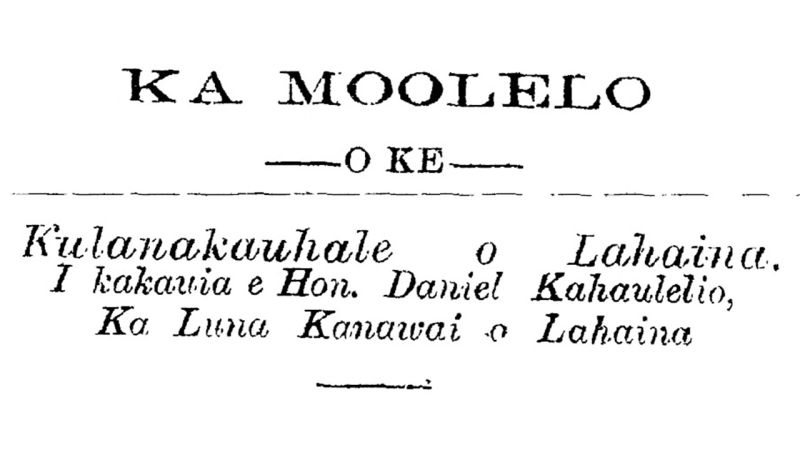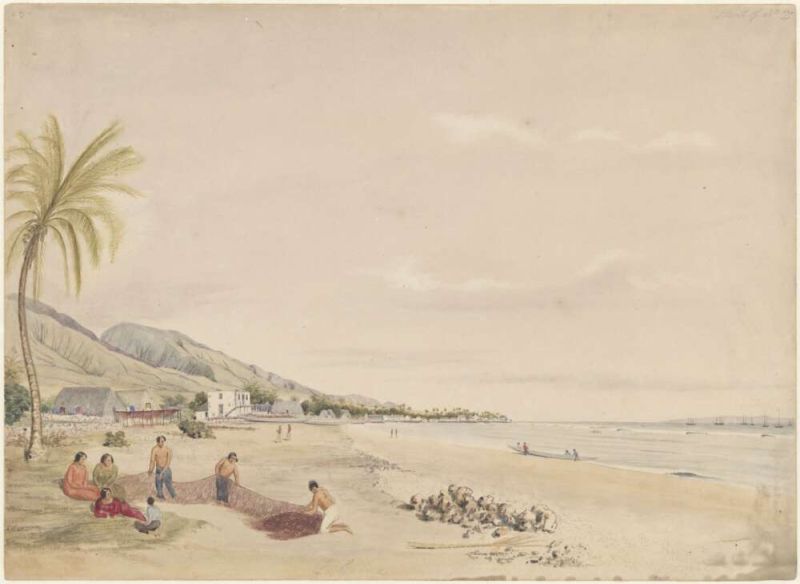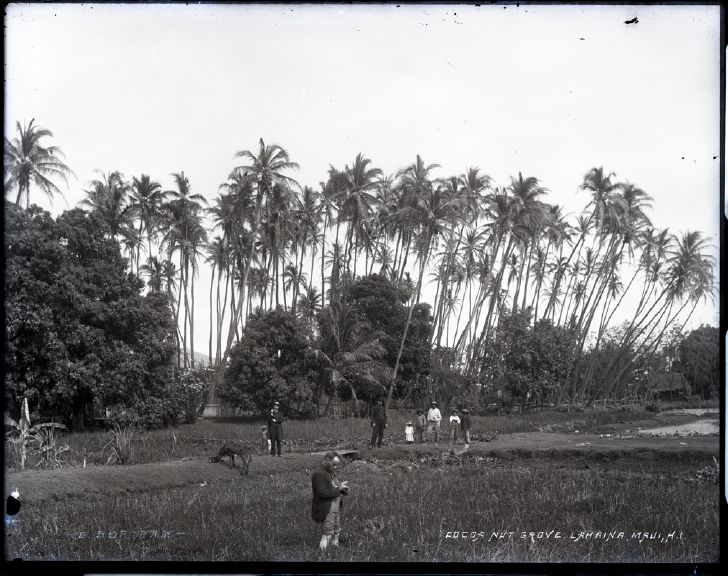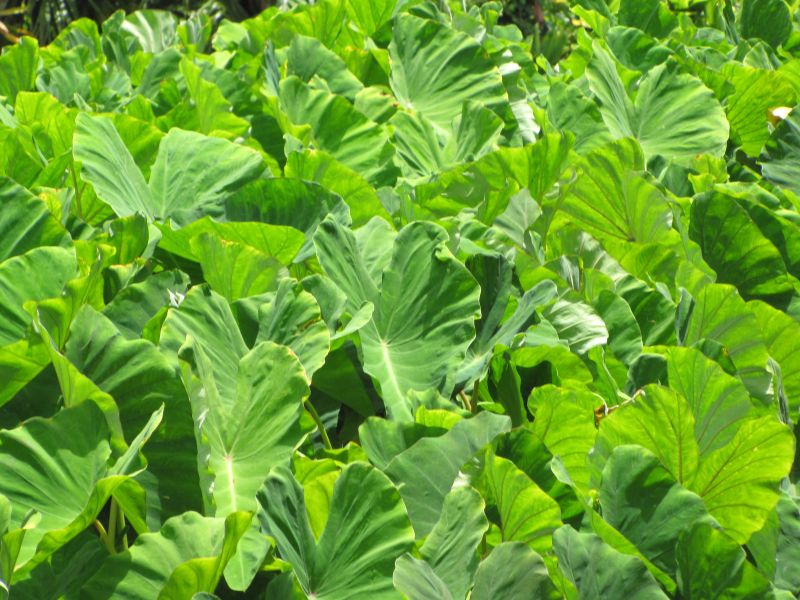Digital Collections
Celebrating the breadth and depth of Hawaiian knowledge. Amplifying Pacific voices of resiliency and hope. Recording the wisdom of past and present to help shape our future.
Published in the Hawaiian language newspaper Ka Lei Rose o Hawaii in June of 1898, this is the first installment in a series of articles written by a native child of Lahaina. The Honorable Daniel Kahāʻulelio begins by describing the position and features of Lahaina town, the way of life of its people, and some of the most impactful changes that took place in the area between the years 1820 and 1830.
The Hawaiian text below (transcribed from the original and adapted to modern orthography) is followed by an English translation.
KA MOʻOLELO
— O KE —
Kūlanakauhale ʻo Lahaina.
I kākau ʻia e Hon. Daniel Kahāʻulelio,
ka Luna Kānāwai o Lahaina.
A i kona ʻike pono ʻana i ka momona o ka ʻāina, ua loaʻa ihola nā hale aikāne a me nā hale hoʻowahine, ua huli hoʻi koke akula ʻo ia i kona ʻāina hānau, iā Keoneʻōʻio, a lawe maila i kona makua kāne, nā kaikuaʻana, kaikaina, a me ka ʻohana a pau, he 10 ka nui ma luna o nā waʻa, a noho malihini ihola ma kahi nō o ka Mea Hanohano, ka Luna Kānāwai D. Kahāʻulelio, e noho nei, ma kahi i kapa ʻia ʻo Makila.
Ua noho a hoʻokamaʻāina ihola lākou ma ia wahi i ka M. H. 1824, ua like me 74 makahiki i hala aʻe nei. E nā makamaka heluhelu, ʻo Lahaina ka ʻāina momona hoʻokahi aʻu i lohe, a aʻu hoʻi e hōʻike aku nei i hui pū ʻia me koʻu ʻike maka no nā makahiki he 50 a ʻoi i hala aʻe nei. A penei e maopopo ai, ʻaʻole e ʻekolu kaulahao mai kahakai mai, e ulu ana nā loʻi kalo nunui, e hele ʻoe mai kēlā peʻa a kēia peʻa o Lahaina, aia nā loʻi kalo e ulu ana ma mua a ma hope o kauhale, he ulu kō hoʻi me ka maiʻa, nā māla ʻuala, nā māla uhi pālau, nā māla ipu haole, ipu pū, kūlina, ʻakaʻakai, kaʻukama, pine, pāpapa, ipu pū, ʻōhiʻa, a pēlā aku, e uhi paʻapū ʻia ana hoʻi ka ʻāina e nā kumu ʻulu, e ka ulu niu, nā kō ʻaki o ka wā kahiko o kēlā a me kēia ʻano. Mai kēia wā a hiki i ka wā ʻānō, ʻoia mau nō ka momona o ka ʻāina, e piha ana nō me kēia mau hua ʻai i haʻi ʻia aʻela ma luna. ʻAʻole au i lohe iki, he mau huaʻōlelo no ka auē, e ʻī ana lā hoʻi, ua wī ʻo Lahaina, ʻaʻole loa! ʻO ka ʻoi loa aku o ka puni a nā malihini, ʻo ke kukui ʻinamona, waipahē a momona ke miki iho ʻoe me kou mau manamanalima, waliwali a palanehe, he keu aku a ke kuhikuhinia.
ʻO ka Lunahoʻoponopono o kēia nūpepa kekahi o nā keiki lālāwai a kupa o ua kūlanakauhale nei, a mākou i holoholo pū ai i ko mākou mau lā ʻōpio, me nā keiki lālāwai ʻē aʻe o ua ʻāina lā i pau aku i ka hala ma kēlā ʻaoʻao, he 40 makahiki i hala aku nei ma hope, ʻo ia kekahi hōʻike ʻoiaʻiʻo o kēia, a me nā kamaʻāina kahiko ʻē aʻe a pau e ola nei o ka ʻāina, ʻaʻole ʻo ia wale nō, ʻo kuʻu mau kaikuaʻana a me kuʻu mau kaikaina, i komo i ke Kula Nui ʻo Lahainaluna mai ka makahiki A. D. 1840 mai a ka makahiki A. D. 1863, ʻo lākou kekahi poʻe nāna e hōʻoiaʻiʻo mai i ke kūlana momona o ka ʻāina o ke kūlanakauhale ʻo Lahaina.
He 2 mau mea nānā e hōʻike maopopo aku i mua o nā malihini i kipa mai e ʻike i ka nani a me ka momona o Lahaina i ia au o ka ʻāina i hala aku. 1. Aia ma uka iho o ka hale makeke kūʻai iʻa, e pili pū ala me ka hale ipukukui, he loʻi kalo nui no nā aliʻi, ʻo ʻApukaiao kona inoa, a ma uka aku o nā hale inu tī, he loʻi kalo no ka Mōʻī Lunalilo i hala, ʻo Loʻinui ka inoa, a ʻo ka ʻoi paha kēia o ka loʻi kalo nui hoʻokahi o Hawaiʻi nei, a he loʻi kalo iho na ke aliʻi Lahilahi, e pili pū ana ma kahi noho o ko ʻoukou mea kākau, i like nō ka nui me ʻApukaiao, he mau kapuaʻi wale nō ke kaʻawale mai ke kai mai, a kahi a kēia mau loʻi kalo i kū ai, aia nō hoʻi nā ʻamaʻama a me nā ʻanae, nā awa, nā āholehole, nā ʻoʻopu, a me nā ʻōpae e holo ana i loko o kēia loʻi kalo, ua hele a momona.
I ke oʻo ʻana o ka ʻai, a manaʻo e hoʻā imu, ua mākaukau nō ka iʻa, eia nō i mua o ka ʻīpuka hale.
ʻAʻole i pau.
THE HISTORY
— OF THE —
Town of Lahaina.
Written by the Honorable Daniel Kahāʻulelio,
Judge of Lahaina.
Once he clearly saw the richness of the land, with houses full of friends and future relations, he immediately returned to his birthplace, Keoneʻōʻio, and brought his father, brothers, and entire family of 10 aboard canoes, to take up residence as a newcomer to where the Honorable Judge D. Kahāʻulelio lives today, at a place called Makila.
They stayed and made that place their home in the year 1824, which was 74 years ago. Beloved readers, Lahaina is the most fertile land I have ever heard of and can attest to, having bore witness to it with my own eyes for over 50 years. What makes it evident is that not even three chain lengths [66 yards] from the shoreline are numerous kalo terraces, and if you travel from one end of Lahaina to the other, kalo is growing in front and back of the houses, along with stands of sugarcane and banana, fields of sweet potato and yam, gardens of watermelon, pumpkin, corn, onion, cucumber, pine, beans, squash, tomatoes, and more, and the land is covered in breadfruit trees and coconut groves, with all sorts of old varieties of sugarcane. From then until now, the richness of the land has remained, still full of these fruits mentioned above. I never once heard any words of woe, exclaiming that Lahaina is suffering famine, not at all! The greatest delight of the foreigners is the relish of candlenut, which is gentle and sweet when dabbed with the fingers, so smooth and subtle, having the most delicious taste.
The Editor of this paper is one of the prosperous native children of this town with whom we used to hang around in our younger days, along with those successful descendants of this land who have passed on to the other realm, as that was some 40 years ago, which is a true testimony of mine and the rest of the old-timers of this place who are still living here, and it was not only him, but also my brothers, who attended Lahainaluna Seminary from 1840 to 1863, they being some who can attest to the fertile condition of the soil of Lahaina town.
There are two things to see that would be shown to visitors who came to experience the beauty and richness of Lahaina in that bygone era. 1. Just inland of the fish market, close to the lighthouse, was a large kalo terrace for the chiefs which was named ʻApukaiao, and inland of the tea houses was a kalo terrace for the deceased King Lunalilo which was named Loʻinui, it being arguably the single largest wetland taro field in all of Hawaiʻi, and there was another kalo terrace for the chiefess Lahilahi, near the residence of your author, which was similar in size to ʻApukaiao, just a few feet away from the ocean, and at the site of these kalo terraces were large and extra large mullet, milkfish, juvenile flagfish, freshwater goby, and shrimp swimming inside which grew quite fat.
When the kalo was mature and plans formed to light the imu, the fish was ready, right there in front of the doorway.
To be continued.


courtesy of: Wikimedia Commons
Lahaina. Watercolor and pencil by James Gay Sawkins, 1855.

courtesy of: Wikimedia Commons
Lahaina coconut grove. Photograph by Brother Bertram, c.1883-1905.

courtesy of: Kapalaiʻula de Silva
ʻInamona, relish made of the cooked kernel of candlenut (kukui) mashed with salt.

courtesy of: Forest and Kim Starr
Kalo (Colocasia esculenta). Waiehu, Maui, 2009.